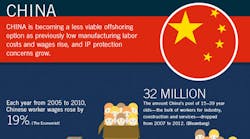Did you know that many of the parts making up the products you may encounter day-to-day, from cars to medical devices, could have traveled to more countries than you have ever been in your life? Picture this: A component born in California is shipped to Toronto to be added to another component. Then it is shipped to Japan to have another component added before it is sent back to Toronto to be partly manufactured. Michigan is its next stop so that it can be installed into another component, then sent down to Mexico where it becomes the final product—now it is ready for the end user.
Manufacturers once thought this process saved them money. When considering labor costs, that may have been the case, but that is one narrow lens. What they weren’t realizing was the mountain of costs—and quality issues—that should also be factored into the price of the final good.
Enter reshoring—a bandwagon on which many U.S. manufacturers are jumping as they realize that offshoring is no longer an “economical” option. A lot of factors make this true, but most significant is the fact that today’s manufacturing landscape, especially here in the U.S., looks nothing like it did when organizations decided to offshore in the first place.
Technological advancements have spurred the need for highly skilled workers. Tasks that were once completed by five individuals can now be done by one, except these tasks require enhanced skills and are churning out more in terms of production. As a result, U.S. manufacturing processes are more advanced, efficient and cost-effective than ever, making the selection of local manufacturing suppliers much more desirable.
Working with local suppliers also brings two important elements in the manufacturing process together—design and production—reducing unnecessary costs, helping to solve unique problems and driving innovation.
The True Cost of Doing Business Overseas
Rising wages overseas have been the catalyst for many manufacturers opting to reshore, but when international blinders are removed, additional costs abound. Consider the unexpected events that could derail a shipment, such as freight issues or weather conditions. A hurricane or tsunami could leave a product docked for weeks, halting production of the other parts comprising the final product. This can lead to an array of costly repercussions, such as loss of the business even after the product has been purchased, as customers can always turn to other suppliers.
A broader economic detriment to the proliferation of partnerships overseas is prototype costs. When the design or prototyping is completed in the U.S. and the company doing the work suspects they will lose volume overseas, they charge higher prices for their work, as they have to account for lost opportunity costs. However, when a supplier knows that the volume will remain consistent, they do not have to inflate the cost to design, a more financially beneficial outcome for everyone.
Quality Takes a Backseat with Suppliers Overseas
Working with suppliers overseas is always a gamble, plain and simple. From the very start of the relationship, many of these suppliers, particularly in Asia, require payment in advance of shipment. But a lot can happen between the order and the shipment.
If a manufacturer orders 1,000 feet of material but only receives 800, or worse, if the material is completely damaged upon arrival, there is no incentive on behalf of the supplier to adjust the order because what was specified may have “technically” left the facility according to the purchase order—and they already have their money.
The risk of counterfeiting is also elevated when working with suppliers overseas. A counterfeit part can lead to failed compliance with safety and environmental standards and even injury. Not to mention damaged reputation and a corresponding decrease in sales should the finished product make it into the users’ hands. For this reason, it is important to consider quality standards beyond what is obvious. An electronics manufacturer could order half a million switches that were sourced in China only to find out that there are incompatibility issues over time.
These scenarios are common enough that they have been widely recognized by many manufacturers that opt to send employees around the world for auditing. However, flying a contingent of human beings to another part of the globe, for what can amount to weeks or several months, to make sure specific parts come back undamaged, is far from cost-effective.
Collaboration with Local Manufacturing Suppliers Drives Innovation
When offshoring work to suppliers overseas, a very critical element is lost: collaboration. Customers want “just the right thing.” They aren’t willing to settle just because a component is what’s available or cheaper than the alternative, especially when it’s not guaranteed to arrive on time. This is a real opportunity for manufacturers that provide new ideas, highly skilled workers and offer a lower total cost of ownership.
We are fortunate in North America. We have abundant raw materials, a consumer market that demands innovation and local suppliers, and manufacturers with the means to get things done.
It also is important to remember that U.S. manufacturing is an entirely different industry than it was in years past. The modern manufacturer must learn to see beyond their tried-and-true processes and products in order to capitalize on more cost-effective and efficient approaches made available through new technologies and upcoming generations of highly skilled workers.
Opening the door to collaboration can support that vision, help solve unique problems, enhance product quality to better serve customers, and in some cases, quicken time to market. Particularly for technologically advanced areas, bringing design and production closer also leads to benefits that enhance creativity and production while driving innovation.
Shirley Monte is a business development manager at FLEXcon,where she focuses on serving customers in laminating, fabricating and other market segments that require high-performance adhesive technology.





